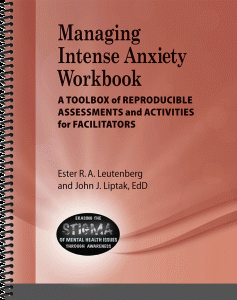Intense Anxiety
By Ester R.A. Leutenberg and John J. Liptak, EdD
Excerpted from Managing Intense Anxiety Workbook
 Anxiety is an inevitable part of everyday life for most people. Some anxiety is actually an appropriate emotional response to a variety of situations that people encounter. It manifests itself in the life of most people in many different ways. Some of the most common types of everyday, “normal” anxiety:
Anxiety is an inevitable part of everyday life for most people. Some anxiety is actually an appropriate emotional response to a variety of situations that people encounter. It manifests itself in the life of most people in many different ways. Some of the most common types of everyday, “normal” anxiety:
- Situational Anxiety – Feelings of apprehension and dread related to a specific situation such as starting a new job, moving to a new community, or learning about a new illness.
- Anticipatory Anxiety – Feelings of apprehension and dread when one confronts something that has been frightening in the past, or that has resulted in a negative experience such as speaking in front of a large group of people.
Anxiety Disturbances – These can be distinguished from the everyday, “normal” anxiety because they are more intense (panic attacks), last longer (often months or years instead of going away after an anxiety-producing situation), and interfere with a person’s ability to function effectively in daily life (i.e., inability to function in a job).
Different types of disturbances related to thinking and behavior are conveyed and expressed in different forms:
- Panic Disorder: People have feelings of extreme terror that strike suddenly and often without any warning. People with panic disorder often experience sweating, chest pain, and/or heart palpitations. They feel as if they are out of control during one of their attacks of fear, and they attempt to avoid places where panic attacks have occurred in the past.
- Social Anxiety Disorder: People have feelings of overwhelming worry and experience extreme self-consciousness in everyday social situations. These worries include the fear that others will judge them harshly, they will do something that may be embarrassing, and the fear of being ridiculed by other people. People with this disorder often are very anxious being around people and have a difficult time talking to others. They will stay away from places where there are other people and have a hard time making and keeping friends.
- Generalized Anxiety Disorder: People exhibit excessive, extreme, and/or unrealistic worry and tension, even if there is nothing (or very little) to be worried and/or tense about. People with this disorder may be worried about just getting through the day and doing everyday tasks. They often have trouble falling and staying asleep, inability to relax, and trouble concentrating.
- Specific Phobias: People experience intense, unwarranted fears about an object or a situation. The fear involved in a phobia is usually inappropriate for the object or the situation and may cause people to avoid specific everyday situations in order to avoid the object or the situation. Some common phobias include snakes, speaking in public, clowns, fear of situations where escape from bad things is perceived as difficult. This represents an intense fear resulting from real or imagined exposure to a wide range of situations.
- Substance-Induced Anxiety Disorder: People experience anxiety caused by substance utilization or withdrawal.
- Anxiety Disorder Due to Another Medical Condition: People have anxiety attacks that can be directly attributed to an existing medical condition (often diagnosed with cancer), and it often parallels the course of the illness.
When to Worry?
Symptoms related to intense anxiety can be very complex and difficult to cope with. The good news is that people can develop the skills needed to manage the symptoms and progress forward to begin enjoying life more. Undergoing the stress that accompanies many of the mental health issues can be a very frightening way to live. People who experience intense anxiety and stress over time are at risk of developing a serious mental or physical illness and need to seek a medical professional.
Suicide Warning!
People who experience intense anxiety may feel suicidal, have suicidal thoughts, and make plans for committing suicide. Sometimes they think that the only way to escape the physical, psychological, and emotional pain is to attempt suicide. Remember to take any talk about suicide or suicidal acts very seriously.
Signs of Suicidal Thoughts
- Calling or visiting people to say goodbye
- Engaging in reckless actions
- Expressing feeling of being trapped with no way out
- Expressing severe hopelessness about the future
- Giving away possessions
- Increasing use of harmful substances
- Talking about killing or harming oneself
- Making a plan for dying by suicide
- Purchasing a weapon
- Putting legal affairs in order
- Withdrawing from family, friends, and activities of interest in the past
Serious Mental Illness
If there is a serious mental illness present, much more must be done than complete the assessments, activities, and exercises contained in this workbook. Serious mental illness must be taken seriously and professionals can take an active role in finding help immediately. All disturbances related to intense anxiety need to be thoroughly evaluated by a medical professional, and then treated with an appropriate combination of medication, and group and/or individual therapy.
*To download four PDF exercises from Managing Intense Anxiety Workbook, click here.

 Because isolation is common in people living with a substance abuse disorder, it’s important for friends and family to know what to look for where suicidal thoughts are concerned. Warning signs may not be overt, but there will likely be some indication that the individual is thinking about self-harm. These can include:
Because isolation is common in people living with a substance abuse disorder, it’s important for friends and family to know what to look for where suicidal thoughts are concerned. Warning signs may not be overt, but there will likely be some indication that the individual is thinking about self-harm. These can include:

 –
–